Ever wondered if poplar wood can brave the elements? Discover the ins and outs of using this versatile yet affordable wood for your outdoor projects!
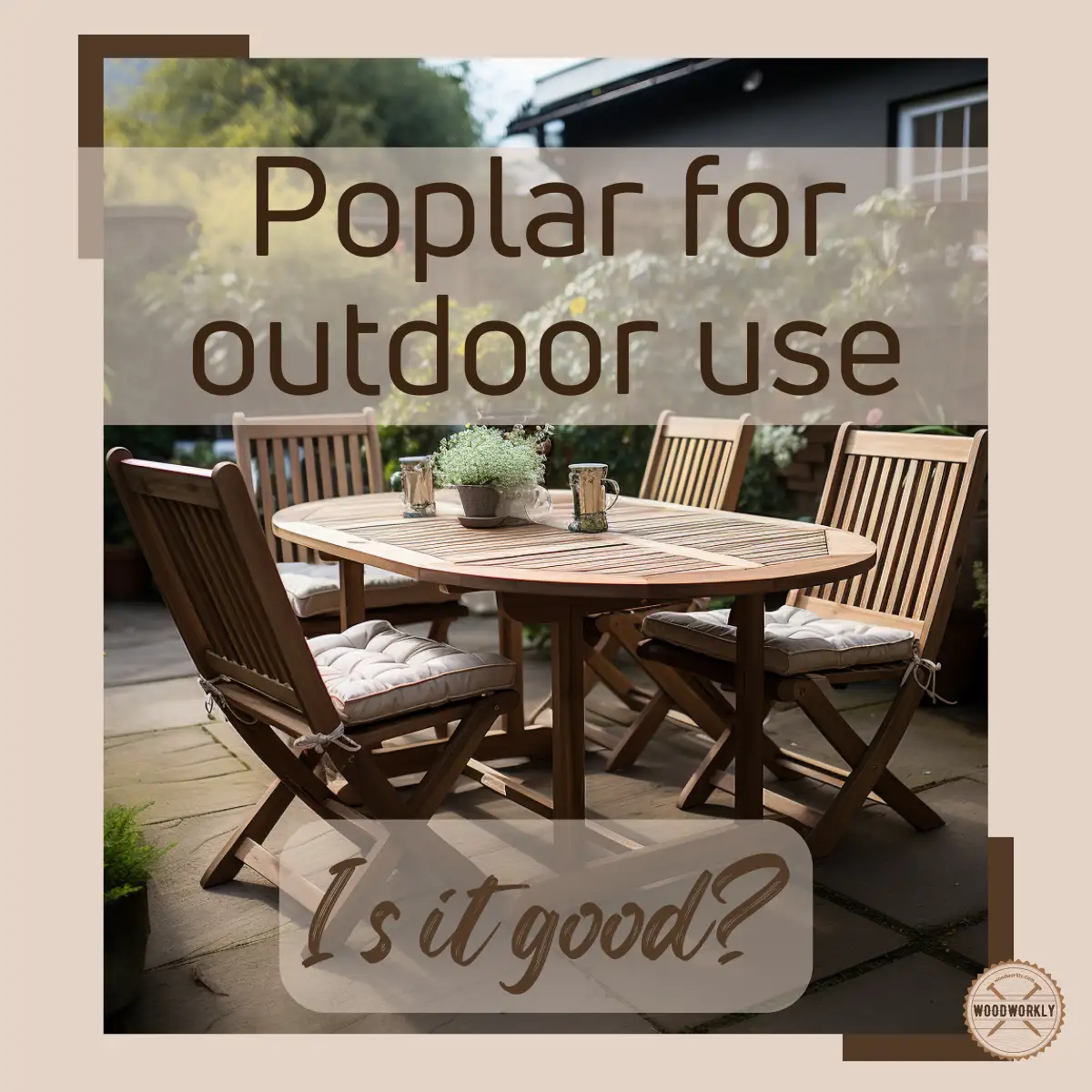
Poplar wood is considered one of the most popular types of wood for various kinds of furniture and other woodworking projects. It is widely found in North America, North Africa, Europe, and Asia.
In my early days, I was curious about the feasibility of using poplar wood to construct a wooden fence.
I was uncertain if it could withstand outdoor weather conditions. To satisfy my curiosity, I sought the expertise of seasoned professionals in the field.

Now, with over 15 years of experience working with poplar, I am well-equipped to share insights on its outdoor applications.”
Let’s discuss, Is Poplar good for outdoor use?
Poplar is good for outdoor use only if it keeps dry and moisture-free. With proper finishing methods, poplar woodworks and furniture are good for outdoor use. Proper maintenance is a must for poplar outdoor uses because poplar isn’t a resistant wood for outdoor elements and decays quickly.
But that isn’t exactly a yes or no question.
So, in this article, I’ll explore the world of poplar wood to find out is poplar good for outdoor use, how to finish poplar for exterior use, the qualities of poplar wood for outdoor use, rot resistivity of poplar wood.
I’ll answer some frequently asked questions as well.
Let’s jump in!
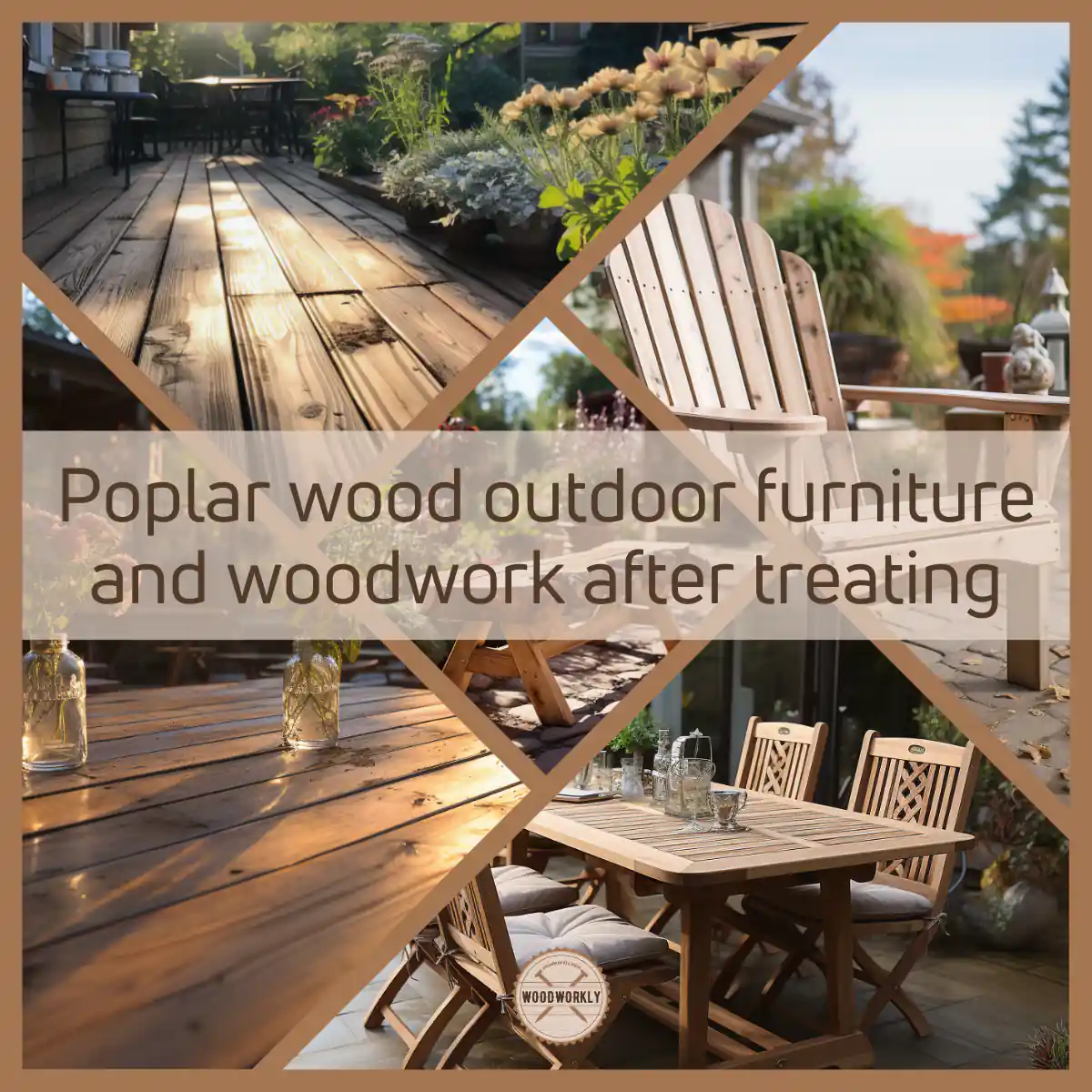
First of all, let’s get a quick look at what type of wood poplar is.
What Is Poplar?
Poplar is a type of wood that encompasses a variety of tree species from the genus Populus, which includes the aspens, cottonwoods, and the classic poplar trees.
Known for its rapid growth and adaptability, poplar is widespread across the Northern Hemisphere, featuring various species that offer distinct characteristics and benefits.
First of all let’s have a look at the poplar wood types.
Types of Poplar Wood
White Poplar
Originating from southern and central Europe as well as central Asia, white poplar wood is distinguished by its light brown heartwood with white stripes, giving it a unique appearance.
Its ease of workability makes it a preferred choice for making pallets, crates, toys, carvings, and furniture frames.
Black Poplar
Black poplar is native to Europe, western Asia, and North Africa.
With its light brown heartwood and pale yellow sapwood, this wood is popular for constructing boxes, crates, plywood, and high-quality furniture.
It’s also valued in the making of musical instruments like drums and guitars.
Yellow Poplar
Also known as “Tulip Poplar” or “American Tulip,” yellow poplar is primarily found in the eastern United States.
It’s known for its yellowish, creamy, or brown heartwood and is widely used in furniture frames, crates, plywood, and pallets due to its stiffness and easy workability.
Eastern Cottonwood
A variant native to the eastern United States, Eastern Cottonwood is soft and known for its ease of cutting.
It’s commonly used to make boxes, crates, plywood, and furniture frames, offering affordability and availability.
Balsam Poplar
Native to Canada and the northern United States, balsam poplar is recognized for its light to dark brown heartwood and creamy or pale white sapwood.
It is typically used in making boxes, pallets, crates, plywood, and furniture, valued for its low density and workability.
Since you already have a brief knowledge of poplar wood, it’s time to focus on the key area which is the outdoor usage of poplar wood.
Just keep reading!
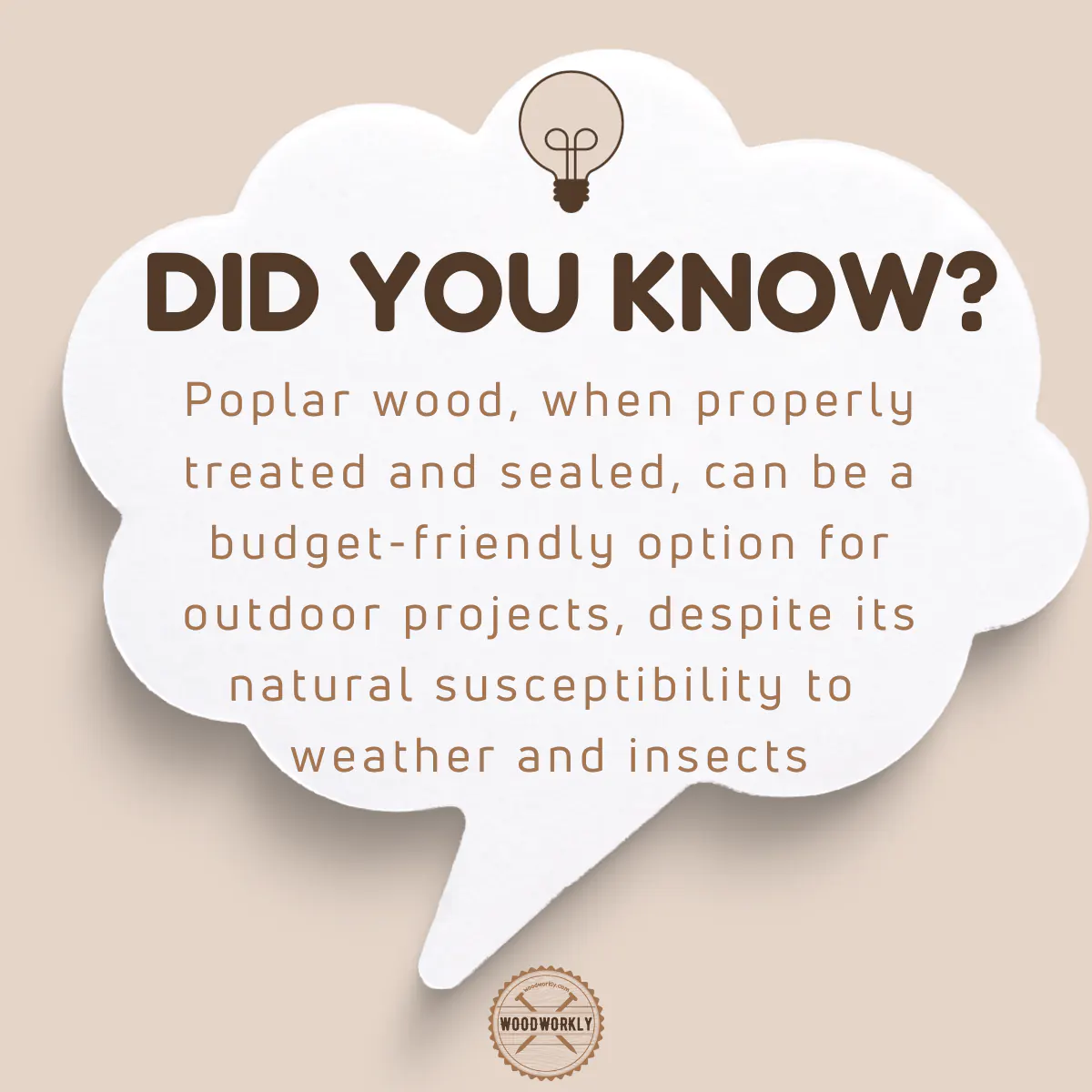
Can Poplar be used outside?
Yes, you can use Poplar for outside, woodwork, and wood carvings without any issue once it is treated with a weather sealer.
But you must make sure to keep it in a dry less moisture environment.
Because poplar is so sensitive to exterior moisture levels and has less resistance to environmental elements.
Even though Poplar wood is less durable than many other hardwoods they are used indoors and outdoors due to its pleasant look.
As you can see poplar got both advantages and disadvantages. Your duty is to treat poplar wood properly before placing it outside to minimize the effects of weather elements.
To increase its durability, you should finish the poplar woodworking project properly for exterior usage.
Without proper finishing, poplar woodwork will never last long and get attacked easily by moisture and temperature fluctuations.
So, give the same attention to the finishing part of poplar wood as much as your effort on making the woodwork or furniture.
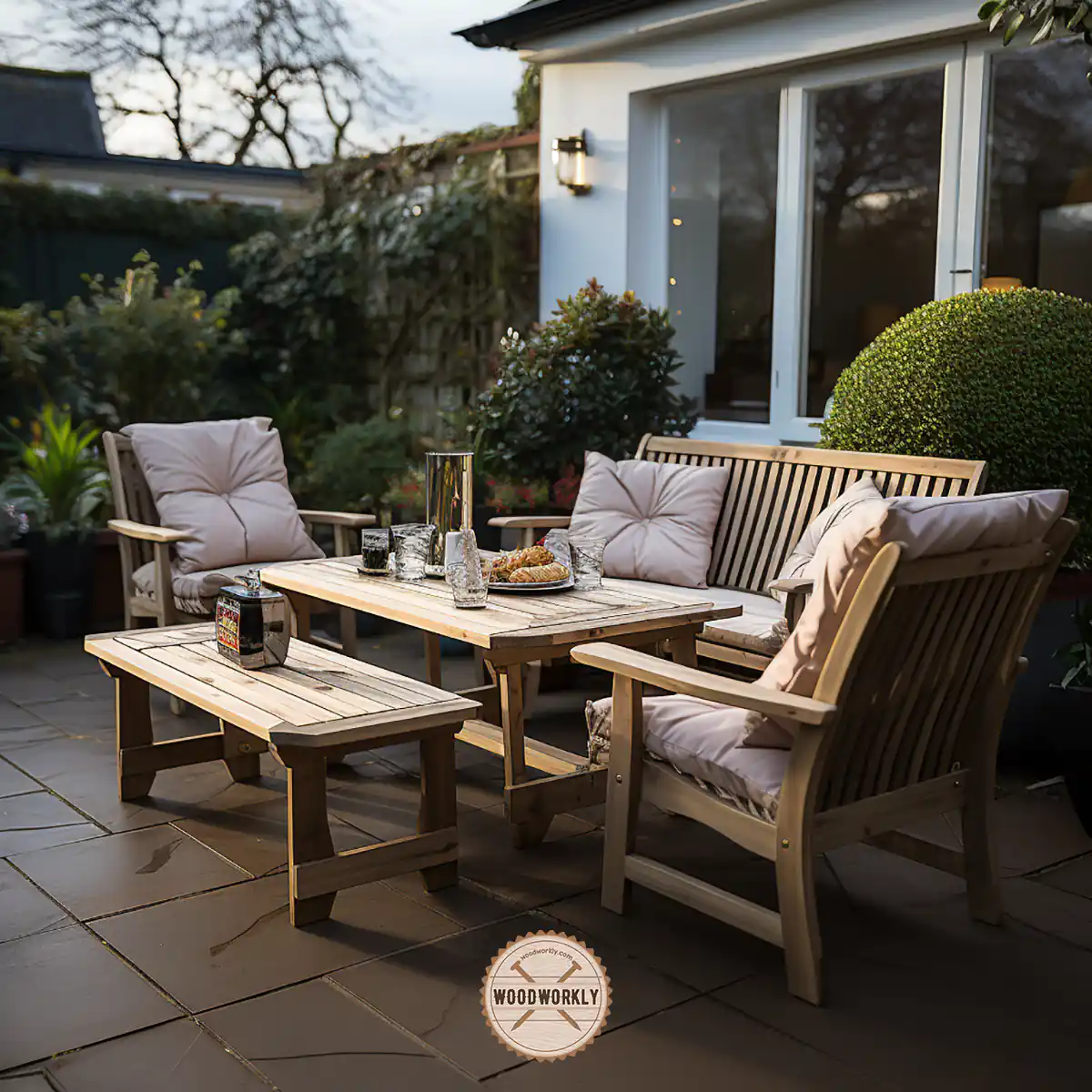
Advantages and Disadvantages of Poplar Wood for Outdoor Use
| Advantages | Disadvantages |
|---|---|
| High strength than many softwoods | Less strength than many hardwoods |
| Uniform texture | Less resistant to water damages |
| Inexpensive | Need to keep the dry, moisture-free environment |
| Lightweight and high mobility | Dent and scratch easily |
| High workability |
Poplar wood is considered a hardwood with relatively high bending strength, compressive strength, and high density than many other softwoods.
But when compared with hardwoods, poplar has one of the lowest strength values than many other hardwoods.
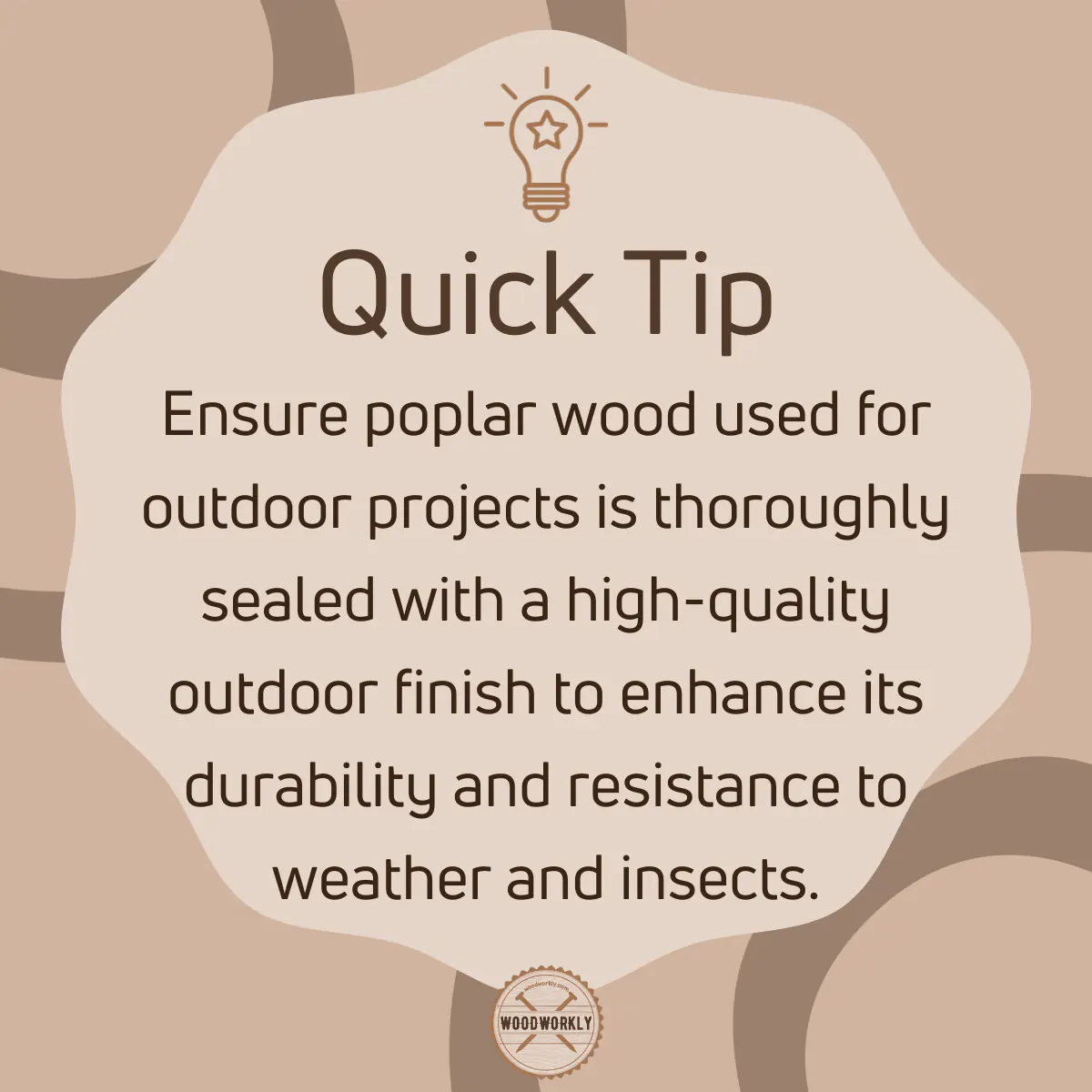
Poplar is new or old-growth; it doesn’t form durable regular heartwood.
Because of that, we need to think twice before placing our lovely woodwork or furniture made from poplar outdoors. The wetting problem will easily decay the wood.
Even though you place the poplar furniture outdoors, I advise you to choose a dry less moisture area for the better good.
Because even if you have done a perfect finishing with paint or sealer, they don’t stop the moisture absorption 100%.
But proper painting and sealing reduce the wetting. Painting the outside of the poplar will reduce the transportation of water droplets from the outside world.
This is why focusing on the finishing part is an essential thing when it comes to using poplar wood for outdoor use.
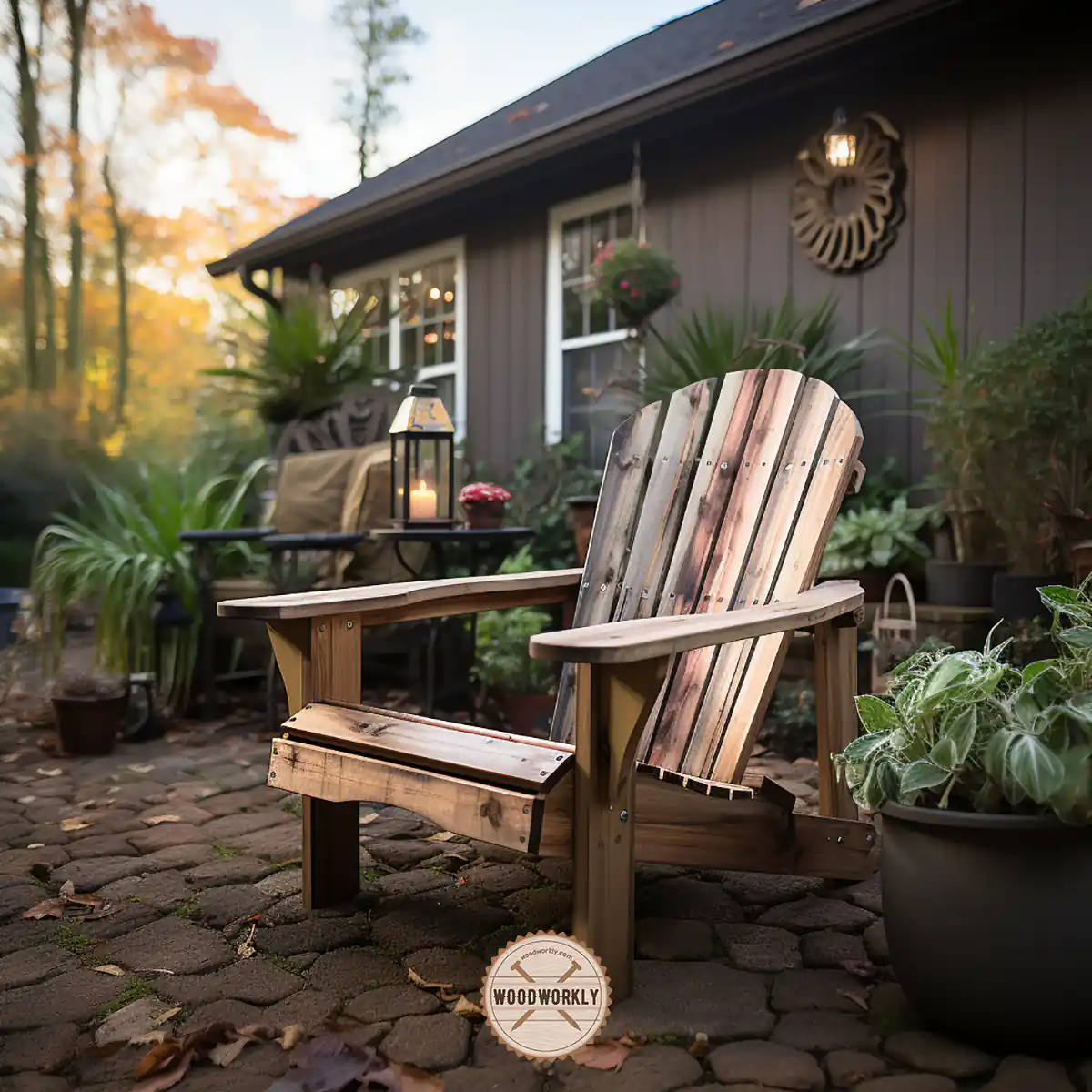
So, let’s discuss how to finish poplar wood for exterior use to eliminate or minimize the attacks from the environmental elements.
Supplies You Will Need To Finish Poplar
- Pre-stain wood conditioner
- Wood stain
- Paintbrush designed for stains
- Rags or old cloth
- 220 grit sandpaper
Collect the above supplies from a quality manufacturer and get ready to finish poplar for outdoor use.
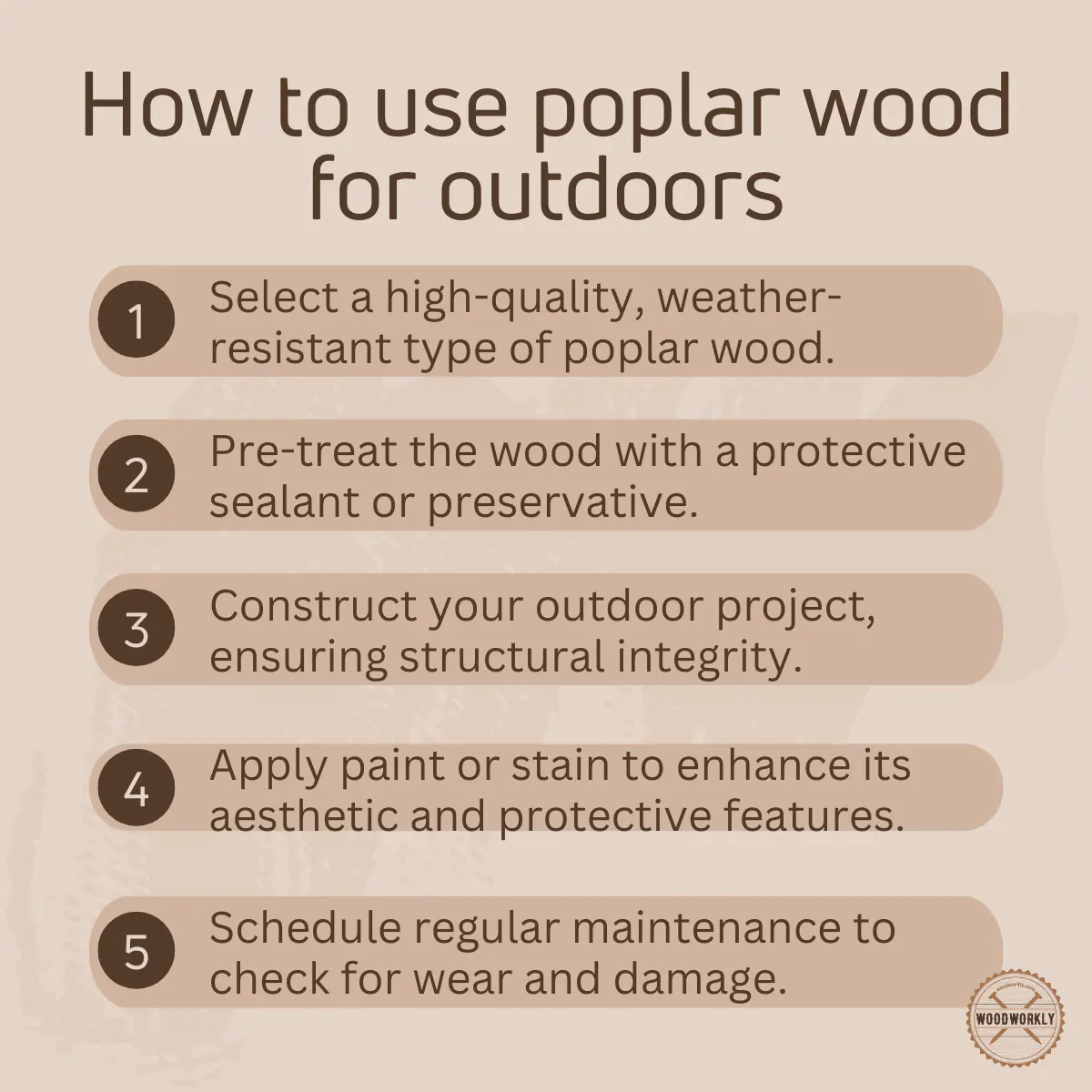
How To Finish Poplar for Exterior Use?
Generally, Poplar wood is easy to stain and paint due to its excellent finishing properties.
If you love the natural aesthetic look of poplar wood, the best method you should follow is to apply stain to finish poplar for exterior use.
The stain will help the wood to minimize moisture absorption from the outside environment and stop the decaying process.
If you have applied the stain correctly, you’ll be able to keep your loving poplar wood furniture or woodwork for exterior use without any issues.
So, let’s find out how to finish poplar wood using stain for exterior use.
Here are the steps you need to follow when finishing poplar wood for outdoor use correctly.
- Clean and sand the wood.
- Apply pre-stain wood conditioner.
- Let the wood sit for 30 minutes.
- Apply the stain.
- Let the wood dry completely.
- Apply the second coat of stain and let it dry completely.
So, let’s explore each of the above steps to finish poplar for exterior use.
This is how you can get a Yes, answer to the burning question, is poplar good for outdoor use?
1. Clean and Sand the Wood
Cleaning and sanding the poplar or any kind of wood before staining is a must in woodworking.
As per requirements, take the 220-grit sandpaper and sand the entire poplar wood surface uniformly without missing a single spot.
Make sure to sand along the wood grain without scratching the surface.
Cleaning and sanding helps to remove unnecessary stuff on wood and make the wood smooth and ready to take on wood stain evenly all over the wood.
220 grit sandpaper is enough to work with poplar wood and higher-grade sandpaper can kill the natural aesthetic look of the beautiful poplar wood.
Plus, they’ll never help the wood stain to take the stain well. So, selecting the perfect grade sandpaper is important when finishing poplar wood.
After you sand the wood uniformly all over the wood, clean it using a rag or old cloth to remove sawdust, dust, and debris which can cause troubles in upcoming staining steps.
So, the cleaning part is a must after sanding.
After you’re done with the sanding and cleaning process, I recommend keeping the wood for 24 hours to make the surface completely dry before moving on to the next step.
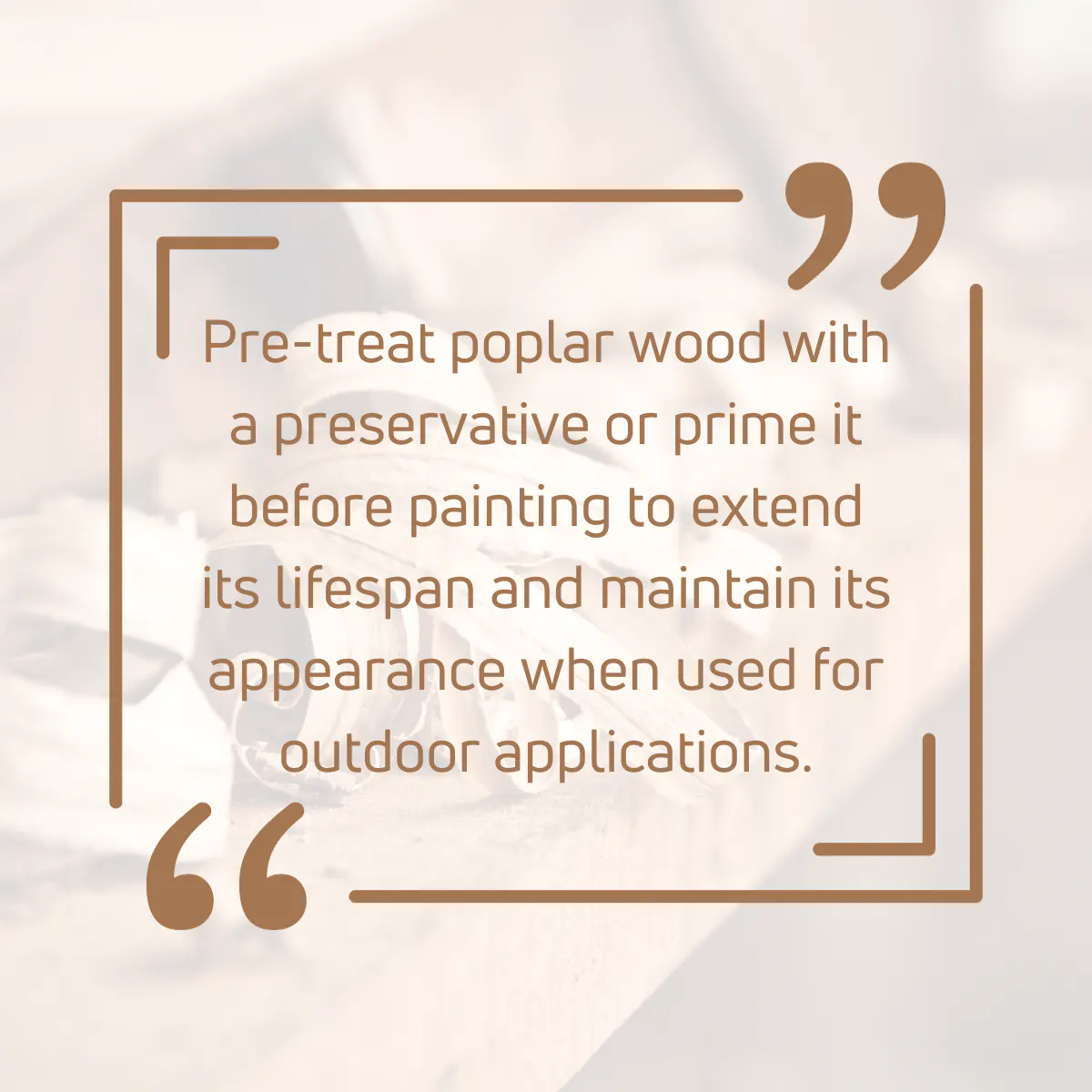
2. Apply Pre-Stain Wood Conditioner
Applying a pre-stain wood conditioner before the stain is an optional step.
But I advise you to apply a pre-stain wood conditioner to make the wood ready to absorb wood stain evenly throughout the surface.
Pre-stain wood conditioner helps the poplar wood to take stain evenly without making most of the wood staining mistakes like getting streaks and blotches when applying wood stain.
Poplar wood absorbs wood stain so easily. Therefore, the amount of wood stain you need to cover up the entire poplar wood surface is high.
By applying pre wood conditioner, it will limit the amount of absorption of wood stain to the poplar wood and save the wood stain by making the top layer with less amount of stain.
I highly recommend Minwax pre-stain wood conditioner for the above process which I have already gained good results.
After successful application of pre-stain wood conditioner, let it sit for about 30 minutes and make sure to wipe off the excess using a dump cloth.
3. Apply the Stain
Now you’re good to go with applying wood stain. Take the paintbrush and dip just the tip of it into the stain.
The stain will run up through paintbrush fibers because the paintbrush will absorb a lot of extra stains. Therefore, we don’t want to put too much on there.
After you have the stain-dipped paintbrush start from the middle of the poplar wood and work to the outside.
That way you’ll not splash over and have run down on the sides of the wood.
Plus, make sure to distribute the stain evenly throughout the wooden surface with even pressure.
Make sure to run the brush strokes through the same direction of the wood grain to avoid crossing with each other with the grain of the wood and the brush strokes.
After the stain is applied for one to two minutes, take the rag or cloth and wipe off the excess stain in the wood. this will help you to avoid any wood stain mistakes.
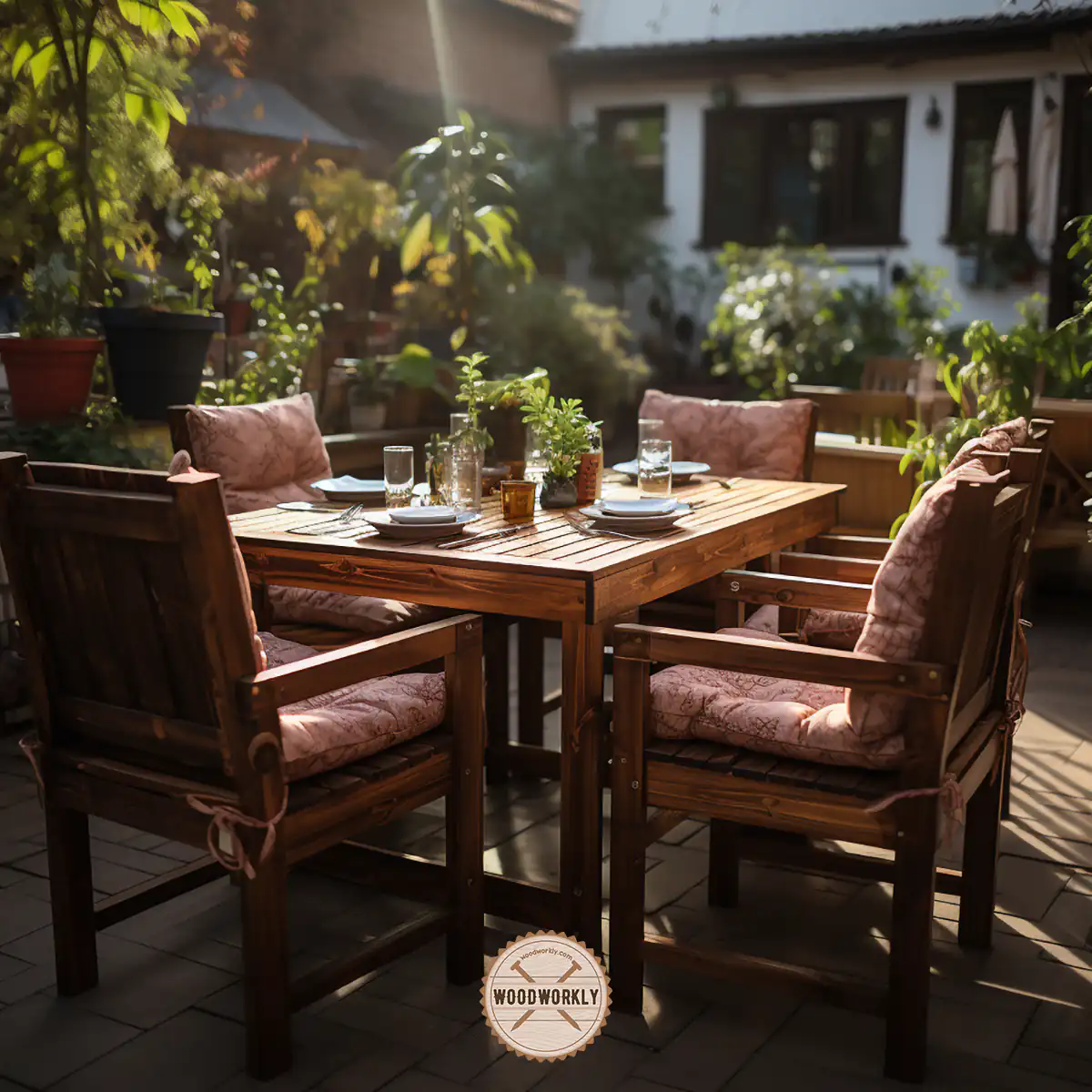
In the wood, there are both hard spots and soft spots. The stain will easily soak into the soft spots and absorb all the stain.
Then stain will sit on top of the hard spots. So, to get a nice even stain surface, you should wipe off all the excess.
If you’re looking to get a specific color, there are many different colors of stain products available in the store.
Select the one that most matches the poplar wood grain.
Also, make sure to open the windows and make the room with good air circulation. Because stain is very potent, and it’ll end up making you sick with a sore throat and runny nose.
4. Let the Wood Dry Completely
After applying the first coat of stain, let the wood dry for nearly 24 hours before going for the second coat of stain.
One coat of stain is probably not enough for wood-like poplar due to its high absorbance.
I highly advise you to wait until the previously applied wood stain is dried completely before applying the next coat because if you applied the second coat of stain to a wet surface, screen blotchiness can happen and at the end of the day, you’ll have to sand down all and start over from the beginning.
So, drying is very important when staining poplar wood.
That’s all about how you can finish poplar for exterior use.
With proper staining, you’ll be able to use poplar woodwork and furniture for outdoor use for long enough.
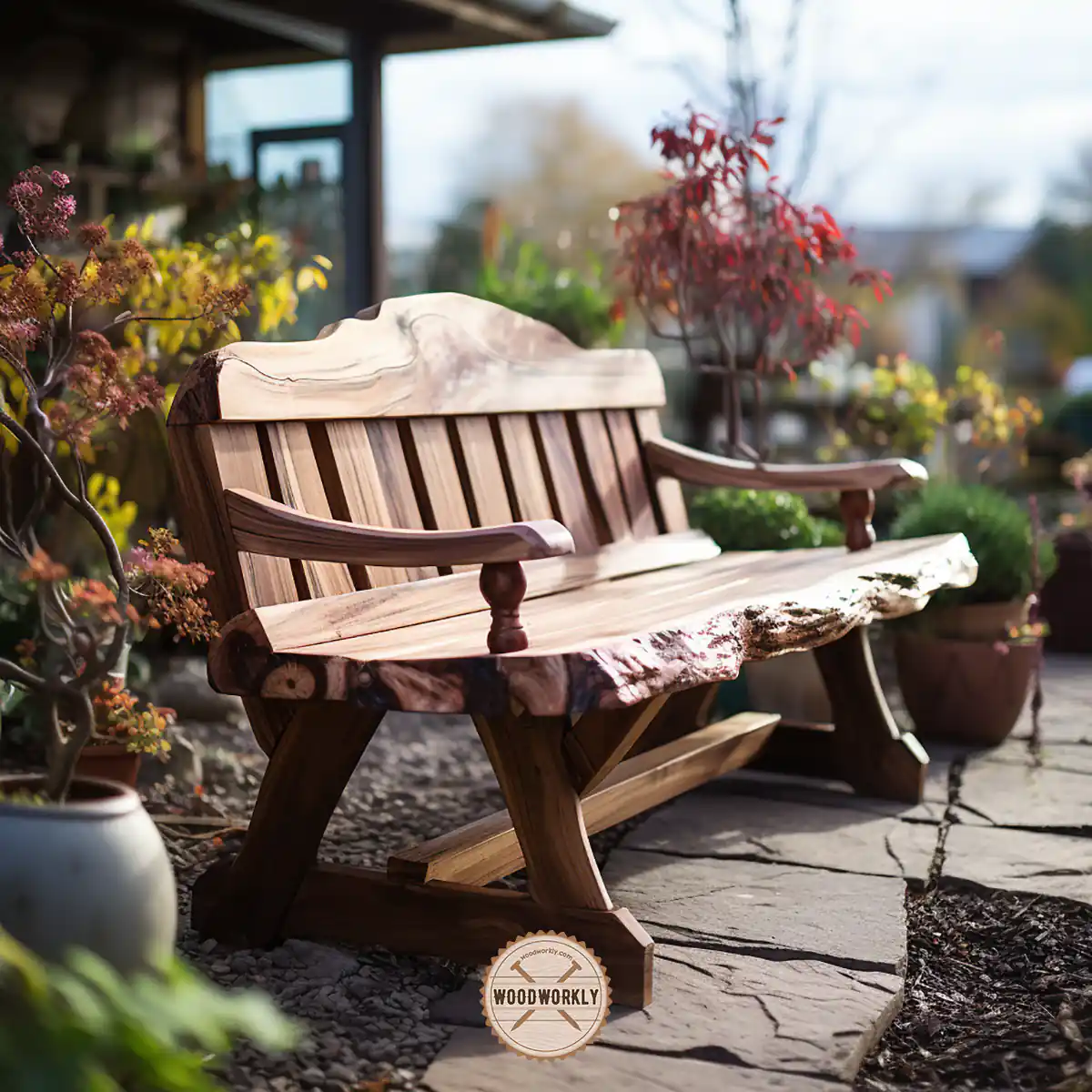
Is Poplar Naturally Rot Resistant?
Poplar wood does not have natural rot resistance. It is highly sensitive to outdoor moisture levels and decays easily.
Poplar wood does not have natural water resistance and therefore water molecules will easily get inside of the wood and start rotting from the inside.
You can prevent the poplar wood from rotting by sealing the wood before keeping it outside.
Is Poplar Water Resistant?
Poplar wood isn’t naturally highly water-resistant, but with the right treatments and precautions, it can be used in environments where it might be exposed to moisture.
For projects that demand high water resistance, other types of wood or adequately treated poplar should be considered.
It’s always essential to weigh the wood’s aesthetic and functional benefits against the environmental conditions of your specific project to make an informed decision.
Is Poplar Weather Resistant?
Poplar is not naturally highly weather-resistant but can be modified and treated to improve its resilience.
The wood’s suitability for outdoor use greatly depends on the specific weather conditions of the project’s location and the maintenance practices applied.
Evaluating these factors ensures that poplar wood delivers the desired performance and aesthetic appeal while withstanding the challenges presented by various weather conditions.
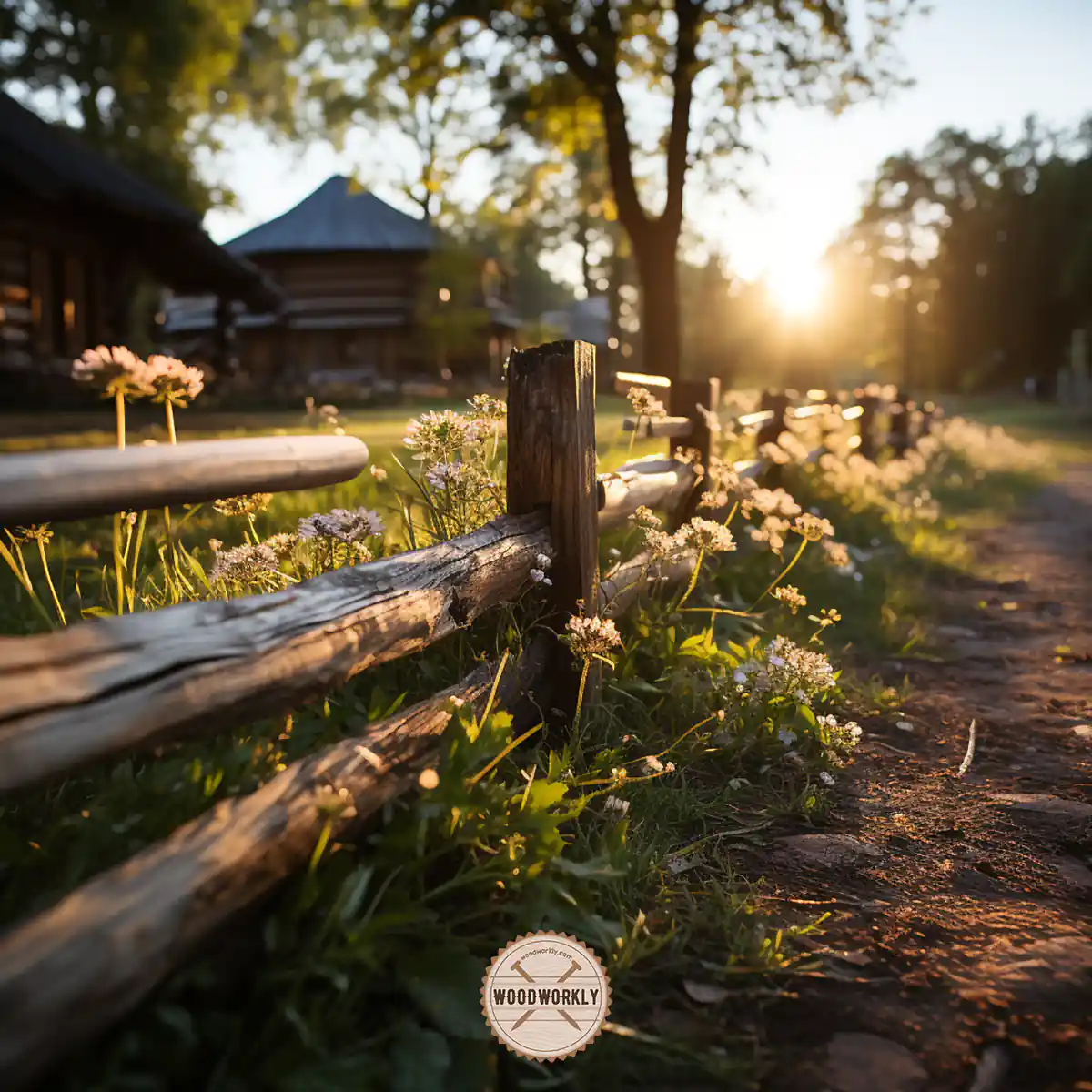
Outdoor Applications of Poplar Wood
With proper finishing, poplar wood is great for outdoor applications.
The uniform texture adds an aesthetic modern look to your outdoor furniture. Here’re some of the common popular wood outdoor applications.
- Adirondack patio chair
- Gardening beds
- Outdoor benches
- Garden gates
As you can see with proper maintenance and finishing you can use poplar wood for almost any application you want.
So, let’s answer some of the frequently asked questions about the outdoor uses of poplar wood.
FAQs
Can poplar wood withstand rain?
Poplar is not highly resistant to moisture and can absorb water if not treated, leading to potential damage. Applying protective finishes can enhance its moisture resistance, making it more suitable for outdoor use in rainy conditions.
Is poplar wood prone to fading in sunlight?
Yes, poplar can be sensitive to UV rays, causing its color to fade over time. Protective coatings that are UV-resistant can help in maintaining the wood’s color and structural integrity.
How often does poplar wood need maintenance when used outdoors?
Poplar requires regular maintenance when used outdoors to protect it from elements like moisture and UV rays. The frequency depends on the specific weather conditions of the location.
Is poplar wood insect-resistant?
Poplar is not highly resistant to insects. Treating the wood with appropriate chemicals or finishes can enhance its resistance to insect infestations.
Can poplar be used for outdoor furniture?
Yes, but with caution. While poplar can be used for outdoor furniture, it needs to be treated and maintained regularly to protect it from weather elements and ensure longevity.
How does poplar compare to woods like cedar or redwood for outdoor use?
Poplar is generally less weather-resistant compared to cedar or redwood. These alternative woods offer natural resistance to weather elements, requiring less maintenance.
Can poplar be painted or stained for outdoor use?
Yes, poplar takes paint and stain well, and applying these finishes can enhance its appearance and resistance to weather elements.
Is treated poplar wood more durable for outdoor use?
Treated poplar wood is more durable and weather-resistant compared to untreated variants, making it a more viable option for outdoor applications.
How does the cost of poplar compare to other woods for outdoor use?
Poplar is often less expensive compared to many other hardwoods, making it a budget-friendly option, though it may require more maintenance.
Is poplar wood eco-friendly?
Poplar trees grow rapidly and are widely available, making poplar wood a more sustainable and eco-friendly option compared to some other types of wood.
Did I cover all you wanted to know about: Is Poplar Good for Outdoor Use?
From this article, I’ve deeply discussed is poplar good for outdoor use and what are qualities poplar wood has that make it good for outdoor use.
I discussed how to finish poplar for exterior use in detail. Furthermore, I have answered some frequently asked questions about poplar wood as well.
Poplar is good for outdoor use with regular maintenance and treatments like painting or staining. Otherwise untreated poplar wood is not ideal for outdoors due to its low resistance to moisture, insects, and rot.
Otherwise, it will rot and decay easily under moist environments.
Hope you have gained good knowledge about is poplar good for outdoor use and how can you minimize its drawbacks to use for any kind of project.
So, let’s start your next outdoor woodworking project with poplar wood with good finishing. Have fun!